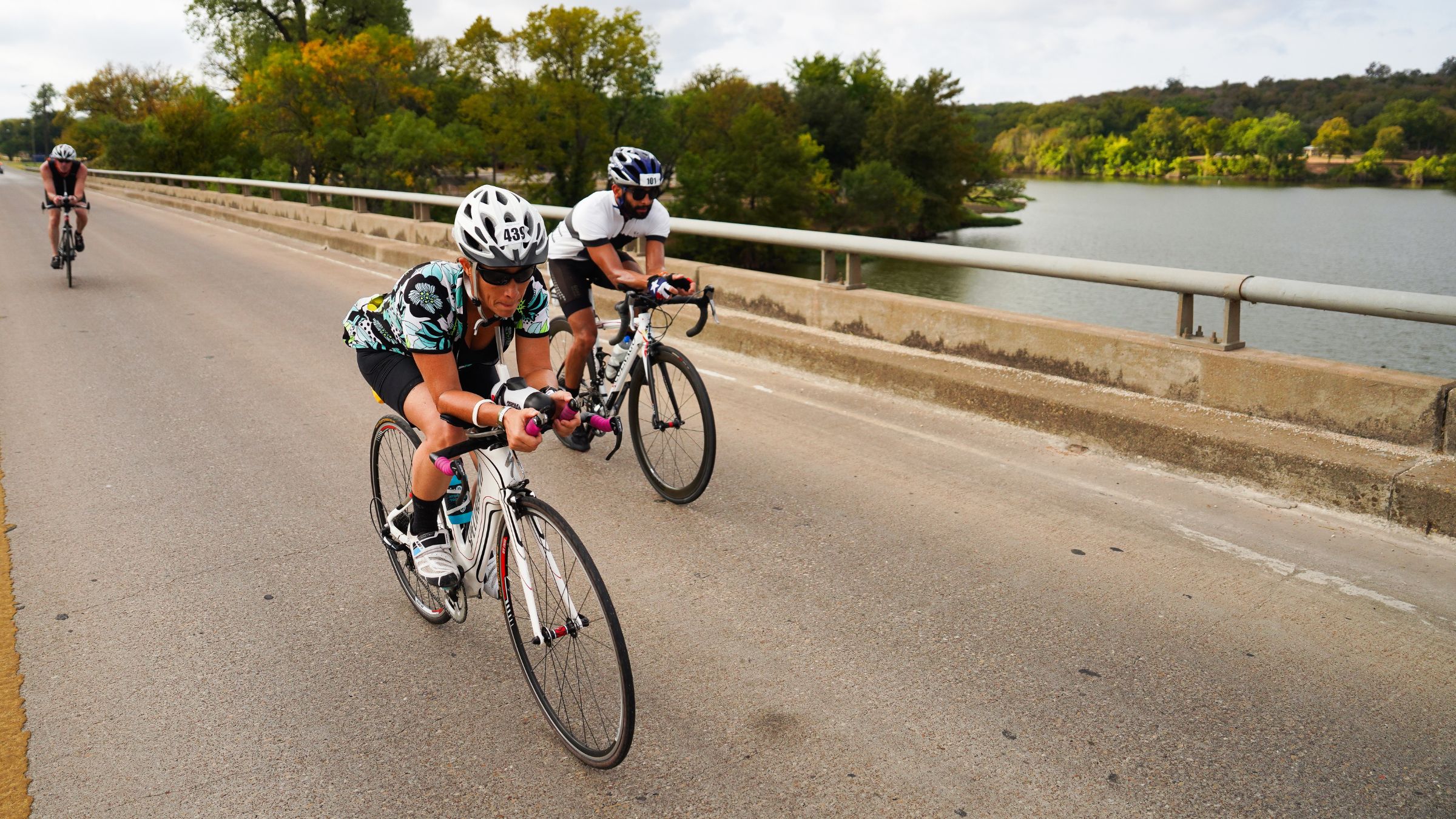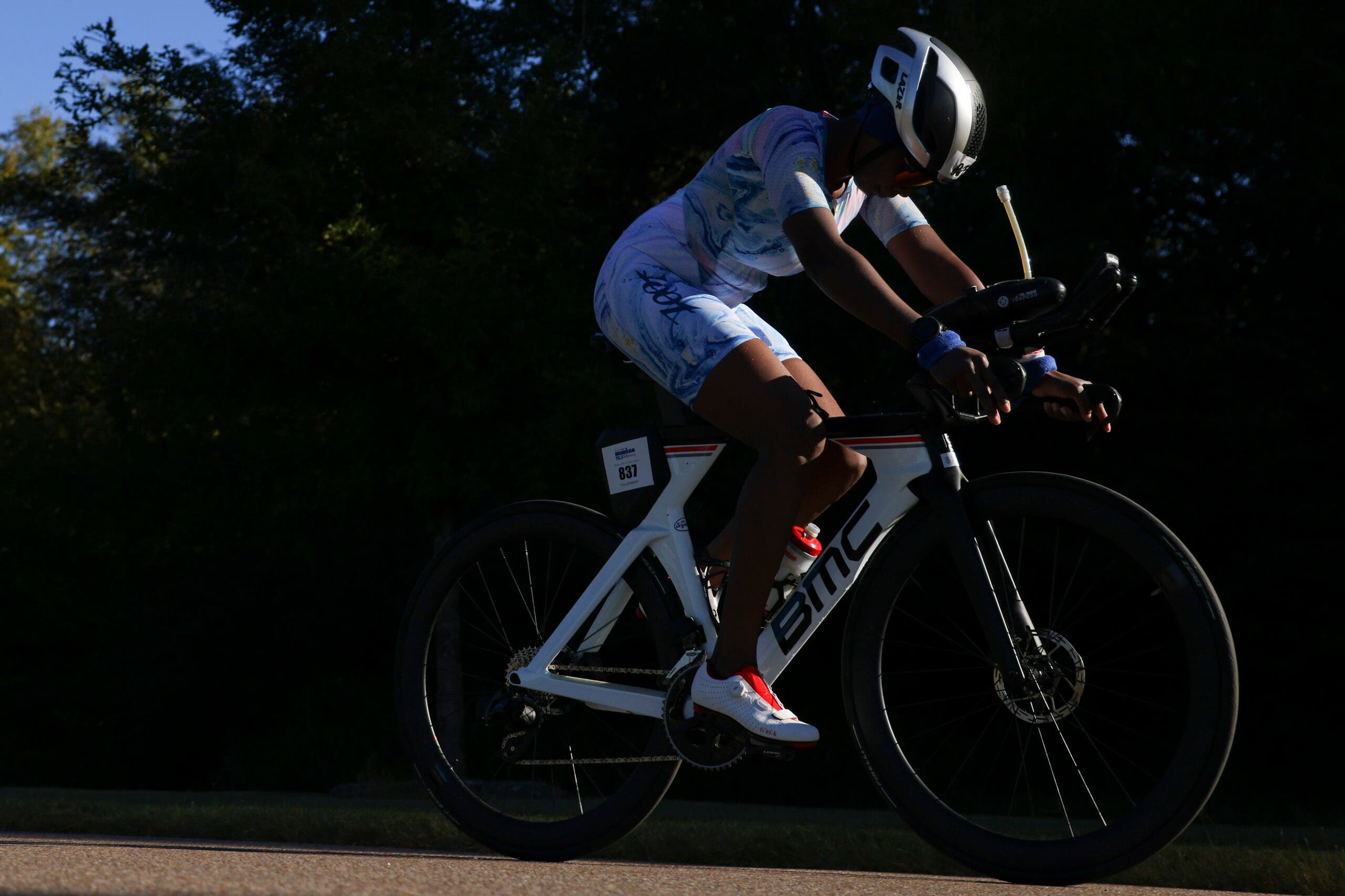What is Power-to-Weight Ratio (and Why Does it Matter)?

(Photo: Alex Bierens de Haan/Getty Images)
A group of cyclists sit outside a local coffee shop enjoying a post-ride cafecito while chatting about their favorite topic: data. One rider reports an FTP of 160, while another has an FTP of 240. Looking at these numbers alone, you might assume that the rider with the higher FTP is the stronger cyclist. But there’s an important detail missing: weight.
It turns out that the cyclist with an FTP of 160 only weighs 120 lbs. She has a power-to-weight ratio of 2.94 watts/kg. In contrast, the rider with an FTP of 240 weighs 180 lbs. His power-to-weight ratio is also 2.94 watts/kg. All things considered, these two riders are very similar.
“When we look at power-to-weight, we’re effectively normalizing the data. This means we can make fair comparisons between riders of all different shapes and sizes,” says sport scientist Dan Plews, Ph.D, then-coach of 2022 Ironman World Champion Chelsea Sodaro.
What is power-to-weight ratio?
Power-to-weight ratio is a reflection of an athlete’s ability to generate power relative to body weight. It’s a helpful tool that can be used to set training zones and track performance gains over time. As seen in the example above, it also provides a standardized measure that can be used to compare the abilities of riders of different weights, experience, and genders.
Coach and co-founder of Training Peaks, Joe Friel, has written extensively about the topic of analyzing power in his book, The Triathlete’s Training Bible.
“Power-to-weight ratio is a measure of how much power, in watts, an athlete can produce on a bike for a given duration, relative to the athlete’s body weight, usually expressed in kilograms (w/kg),” Friel says. “It’s commonly used as a way of expressing an athlete’s functional threshold power, or FTP.”
With the popularity of indoor cycling platforms like Zwift, Rouvy, and Trainer Road, many cyclists will be familiar with power-to-weight ratio, as watts/kg is listed next to every name in the app. Upon joining one of these platforms, an athlete must first do an FTP test to determine functional threshold power. This value can then be used to set training thresholds for workouts and provide a guideline to join group rides with cyclists of similar ability.
RELATED: FTP Test vs. Ramp Test: Which to Do, When, and Why
How to calculate power-to-weight ratio
A watt is a measurement of power, or energy transfer, that’s calculated by a power meter. To calculate a power-to-weight ratio, simply divide power by weight in kilograms.
Power-to-weight ratio chart
| 130W | 160W | 190W | 210W | 240W | 270W | |
| 120 lbs/54.4 kg | 2.39 | 2.94 | 3.49 | 3.86 | 4.41 | 4.96 |
| 140 lbs/63.5 kg | 2.04 | 2.51 | 2.99 | 3.30 | 3.77 | 4.25 |
| 160 lbs/72.6 kg | 1.79 | 2.2 | 2.61 | 2.89 | 3.30 | 3.71 |
| 180 lbs/81.6 kg | 1.59 | 1.96 | 2.32 | 2.57 | 2.94 | 3.30 |
| 200 lbs/90.7 kg | 1.43 | 1.76 | 2.09 | 2.31 | 2.64 | 2.97 |
In this chart, it’s easy to see that a 140-pound rider with an FTP of 210w, a 160-pound rider with an FTP of 240w, and a 180-pound rider with an FTP of 270w, all have a power-to-weight ratio of 3.30 w/kg.
When power-to-weight ratio is important (and when it’s not)
Success in triathlon is ultimately determined by an athlete’s ability to overcome the influence of external forces, like water, wind, and terrain, in the most economical (and fastest) means possible. Power-to-weight can be a useful metric in analyzing that effort, especially when climbing hills. However, in certain scenarios, absolute power, or even normalized power, is more important than watts per kg.
RELATED: What is Normalized Power vs. Average Power?
Friel provides an example of a young, experienced, age-group athlete who weighs 154 lbs (70kg) and has an FTP of 280w. To calculate his power-to-weight ratio, we take power (280w) divided by weight (70kg), which equals 4w/kg. This rider has a high power-to-weight ratio and should have an advantage when climbing hills; however, that doesn’t guarantee he will perform as well on a flat course.
“It depends on the conditions we’re using to measure performance,” Friel says. “If it involves climbing a hill, a high power-to-weight ratio is a great advantage. But if there’s no hill, and therefore gravity is inconsequential, absolute power for an extended period of time is a better indicator of performance.”
When riding uphill, it makes sense that a larger rider will be more powerful than a smaller rider. However, a smaller rider will need less power to propel his/her body mass up the hill against the force of gravity. Therefore, this is when a high power-to-weight ratio is most beneficial.
In contrast, on a flat or rolling course, aerodynamics and absolute power are more important than watts per kilogram. Although a larger rider will have more frontal drag, and therefore wind resistance, than a smaller rider, this is outweighed by the larger rider’s ability to generate more power.
“Typically, the higher one’s w/kg, the faster that rider can go up a hill,” Friel says. “Conversely, on a flat course, w/kg has little value. In fact, on a perfectly flat course, the more significant matter is total power output, regardless of weight, since gravity, and therefore weight, are not factors in one’s speed.”
RELATED: Do’s And Don’ts Of Tackling Hills On The Bike
Of course, the importance of aerodynamics and reducing drag in triathlon cannot be understated. However, because the difference in wind resistance between a large rider and a small rider will be minimal, absolute power still wins the day.
“The only issue then is wind resistance, or drag,” Friel confirms. “Since the drag (frontal area) of a large rider, who, because of size, can put out a lot of power, is not significantly different from that of a smaller rider, on a flat course, the bigger rider has the advantage.”
Plews explains that’s why larger cyclists often have an advantage in many scenarios.
“This is why we tend to see bigger athletes doing well in cycling time trials and also Ironman races,” he says. “This is when comparing to climbers in cycling and Olympic-distance triathletes. In road racing, power-to-weight can also be important for achieving fast accelerations as well.”
RELATED: What is Coefficient of Drag—And Why Should You Care?

Why we shouldn’t fixate on weight
In an effort to improve your power-to-weight ratio, it makes sense that losing a few pounds might help. However, it’s not always that simple.
“Mathematically, if an athlete loses weight simply to increase power-to-weight ratio, there could be a significant increase in climbing performance, but not performance on flat courses,” Friel says. “In the real world, the problem with this strategy is that the athlete could lose enough weight that his/her recovery suffers.”
“A loss of weight can be stressful to the system, much as overtraining is. For some athletes who are significantly overweight, however, losing weight could improve climbing ability.”
If a rider is already fit, losing more weight might actually be detrimental. This is because the weight of a human body refers to its relative mass, which includes bones, muscles, tendons, and organs, not just fat. There is a point of diminishing returns, when a rider might sacrifice power by losing too much weight.
Plews explains that this point will be different for each athlete. “The more lean body mass [an athlete has] means the ability to apply more force and power,” he says. “Of course, if you get too light and lose too much lean mass, absolute power can be reduced. This would be the point of diminishing returns. This actual point is very individual.”
Even if an overweight athlete might benefit from losing excess weight, Friel explains that losing it too fast can cause more harm than good.
“The key here is to lose any excess weight very gradually over a long period of time,” he says. “Even though an athlete may be overweight, a rapid loss of excess pounds can still be stressful to the athlete and result in poor race performance, even though excess weight was shed. The body doesn’t like rapid system changes.”
Overall, actual power is more important than power-to-weight in most cycling scenarios. But, this ratio can be improved with structured training, regardless of how much an athlete weighs. Incorporating high-intensity efforts to increase power output, as well as doing strength training off the bike (like squats and deadlifts), can be beneficial.
RELATED: Ask Stacy: How Do I Balance Weight Loss and Well-Being With Performance Gains?
What’s the ideal power-to-weight ratio?
Because all riders are different, it’s hard to define an ideal power-to-weight ratio. “All of this is quite individualized since athletes aren’t all the same when it comes to their physiological needs and how they respond to training, both physically and mentally,” Friel confirms.
Instead, he uses a phenotype scale that’s based on body weight and height to help athletes determine the type of race course that suits them best. Begin by dividing your body weight (in lbs.) by your height (in inches). This creates your phenotype quotient.
Phenotype quotient chart:
| Male | Female | Preferred Race Type |
| <2.0 | <1.8 | Very hill courses, with long climbs |
| 2.0-2.31 | 1.8-2.1 | Some hills OK, mostly short |
| 2.4-2.5 | 2.2-2.3 | Very few (if any) hills, very short and not steep |
| >2.5 | >2.3 | Flat courses |
For example, an athlete who is 5’6” (66 in) and weighs 130 pounds has a quotient of 1.97, meaning she will excel on courses with some short climbs.
“This isn’t a perfect indicator for all athletes. It only provides a ballpark,” Friel says. “There are unique physiological markers that may allow a 2.3 phenotype to climb quite well and a 2.0 to climb very poorly. I’ve seen this happen, but it’s not common.”
Plews has created many workouts for Zwift Academy Triathlon and provides a basic guideline for average FTP scores. “Generally, untrained riders have an FTP below 2.0 w/kg for men and 1.5 w/kg for women, while professional racers may be capable of sustaining more than 6.0 w/kg for men and 5.5 w/kg for women.”
How to improve your power-to-weight ratio
There are three main ways an athlete can improve power-to-weight ratio: improve fitness and maintain the same weight; improve fitness and lose weight; and maintain fitness and lose weight.
“There are two components in the formula we’ve been discussing here: power and weight,” Friel says. “Theoretically, an athlete can change either or both. I’ve discussed weight loss, but what about power output? Can that be improved? Yes!”
Working to improve your power output, and thus overall fitness, can be accomplished by implementing a training plan with goals that are specific, realistic, and measurable. Friel suggests athletes start by building an aerobic base, along with working on bike skills and muscular strength, over a period of several weeks. Then, the training focus can shift to incorporating efforts at race-like intensity that are specific to a goal event.
“It comes down to three physiological markers: aerobic capacity (VO2 max), lactate threshold, and economy,” Friel says. “Creating a training regimen and plan based on improving these over a long period of time (months, not days) has the potential to improve an athlete’s power output.”
Ultimately, power-to-weight ratio is just another metric that can be used to assess fitness, like heart rate or rate of perceived exertion. It has value when creating training zones for workouts and as a standard to compare cyclists of different sizes and abilities. With a consistent and well-thought-out training regimen, you can improve your power-to-weight ratio and, thus, overall fitness as a well-rounded triathlete.